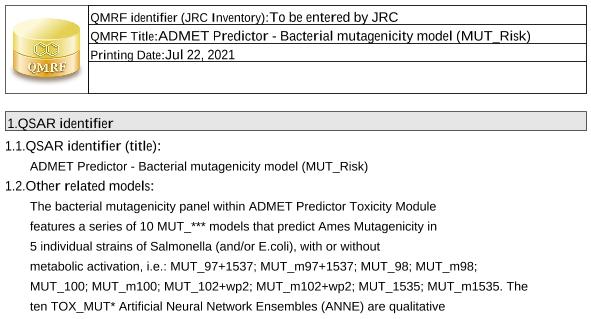Daga, P. ADMET Predictor - Bacterial mutagenicity model (MUT_Risk). 2020.
QDB archive DOI: 10.15152/QDB.255 DOWNLOAD
QMRF document
Citing
When using this QDB archive, please cite (see details) it together with the original article:
-
Lawless, M. Data for: ADMET Predictor - Bacterial mutagenicity model (MUT_Risk). QsarDB repository, QDB.255. 2021. https://doi.org/10.15152/QDB.255
-
Daga, P. ADMET Predictor - Bacterial mutagenicity model (MUT_Risk). 2020.
Metadata
| dc.date.accessioned | 2021-09-02T14:45:00Z | |
| dc.date.available | 2021-09-02T14:45:00Z | |
| dc.date.issued | 2021-09-02 | |
| dc.identifier.uri | http://hdl.handle.net/10967/255 | |
| dc.identifier.uri | http://dx.doi.org/10.15152/QDB.255 | |
| dc.description.abstract | MUT_Risk Abstract The Ames bacterial mutagenicity test is an important regulatory screen for potential carcinogenicity. In silico prediction of Ames positivity plays two important but somewhat distinct roles in the discovery and development of biologically active compounds. A positive Ames test does not necessarily derail development of an active ingredient (AI) because some bacterial mutagens are not carcinogenic. As a practical matter, however, demonstrating non-carcinogenicity is challenging enough that having a robust predictive model for Ames mutagenicity is a very cost-effective alternative to automatically testing every active compound, especially since the model can be used to help decide which particular compounds to synthesize or purchase. In addition, regulatory guidance now allows the use of in silico predictions of mutagenicity to help justify waiving Ames testing requirements for impurities; ADMET Predictor®’s MUT_Risk qualifies as a “statistical model” under ICH M7. Its inputs are the predictions from a set of 11 artificial neural net ensemble (ANNE) models, two for each of five standard genetic backgrounds (S. typhimurium strain TA98, TA100, and TA1535; S. typhimurium strain TA97 or TA1537; or S. typhimurium TA102 or E. coli WP2 uvrA) with or without metabolic activation in S9 cell fractions as well as one trained on data obtained from a collaboration with Japan’s NIHS (Honma et al. 2019; doi 10.1093/mutage/gey031). Models for metabolically activated samples are designated “MUT_mXXX”, where the XXX indicates the genetic background(s) for the data upon which the model is based, e.g., MUT_m100. The corresponding models for samples assayed without activation are designated “MUT_XXX”, e.g., MUT_100. The model based on the NIHS data combines results from all 5 standard strains with and without metabolic activation; it is designated “MUT_NIHS”. A QMRF is available for each individual model. The overall MUT_Risk score is obtained as a weighted sum wherein each positive prediction from a model based on NIHS data or an individual strain other than S. typhimurium TA98 or TA100 contributes 0.6; positive predictions for TA98 or TA100 only contribute 0.3 to reflect the observed high correlation between experimental positives in these two genetic backgrounds. The MUT_Risk rules are formulated such that a positive prediction for either a MUT_XXX model or for the corresponding MUT_mXXX model or for both increments the overall MUT_Risk score by the same amount – i.e., the risk rule syntax prevents double counting. By default, an out-of-scope prediction increments the score by 50% of the weight of a positive prediction irrespective of whether the prediction is positive or negative. The MUT_Risk score itself is suitable for prioritizing compounds for Ames testing or deprioritizing them for synthesis. The default threshold of concern in a regulatory context (e.g., ICH M7) is a MUT_Risk > 1, which accommodates the rather low inter-lab reproducibility (85% or less; see Hansen et al. 2009; doi 10.1021/ci900161g) of the experimental data upon which the models are based. Confidence estimates (doi 10.1186/1758-2946-6-34) are provided for each contributing model’s in-scope prediction, and thresholds have been set low out of an abundance of caution. Hence some positive predictions have quite low confidences, which users should take into consideration when the MUT_Risk score exceeds 1. About 15% of the compounds in a 2260-drug reference subset of the World Drug Index have a MUT_Risk score > 1.0 and 10% have a MUT_Risk score > 1.25. | en_US |
| dc.publisher | Michael Lawless | |
| dc.rights | Attribution-NonCommercial-NoDerivatives 4.0 International | * |
| dc.rights.uri | http://creativecommons.org/licenses/by-nc-nd/4.0/ | * |
| dc.title | Daga, P. ADMET Predictor - Bacterial mutagenicity model (MUT_Risk). 2020. | |
| qdb.property.endpoint | 4. Human health effects 4.10. Mutagenicity | en_US |
| qdb.property.species | Salmonella typhimurium and Escherichia coli | en_US |
| qdb.descriptor.application | ADMET Predictor 10.0 | en_US |
| qdb.descriptor.application | ADMET Predictor 10.0 | en_US |
| qdb.prediction.application | ADMET Predictor 10.0 | en_US |
| bibtex.entry | techreport | en_US |
| bibtex.entry.author | Daga, P. | |
| bibtex.entry.title | ADMET Predictor - Bacterial mutagenicity model (MUT_Risk) | en_US |
| bibtex.entry.year | 2020 | |
| qdb.model.type | Ensemble model (classification) | |
| qdb.model.qmrf | QMRF_ADMET_MUT_Risk-v4 | en_US |
Files in this item
| Name | Description | Format | Size | View |
|---|---|---|---|---|
| QMRF_ADMET_MUT_Risk-v4.pdf | n/a | 39.99Kb | View/ |
|
| QMRF_ADMET_MUT_Risk-v4.xml | n/a | application/qmrf-xml | 36.47Kb | View/ |

Files associated with this item are distributed
under Creative Commons license.
under Creative Commons license.
This item appears in the following Collection(s)
-
QMRFs for mutagenicity models
The QSAR Model Reporting Format (QMRF) documents for mutagenicity models.
